| Photo | Location | Start | End | Status | Notes | Refs |
|---|
|
|---|
 | Portland, Maine | 1859 | 1952 | Extant | In use as private medical facility; see United States Marine Hospital (Portland, Maine) | [2] [4] [9] [19] [20] |
 | Boston, Massachusetts/
Chelsea, Massachusetts | 1800 | 1804 | | The first Marine Hospital established; temporary location in rebuilt barracks at Castle Island | [5] [9] [19] [21] [22] [23] |
 | 1804 | 1825 | Demolished | At Charlestown Navy Yard; transferred to the Navy and demolished |
| 1825 | 1827 | | Temporary rented facility in Charlestown |
 | 1827 | 1857 | Destroyed | In Chelsea; after being sold, it was used as the Hawthorne School and then burned in the 1908 Chelsea fire. |
 | 1857 | 1940 | Extant | Built near Chelsea Naval Hospital; in use as apartments |
 | 1940 | 1981 | Extant | In Brighton; in use as private hospital facility |
 | Vineyard Haven, Massachusetts | 1879 | 1952 | Extant | In use as Martha's Vineyard Museum | [4] [9] [19] [24] |
| Newport, Rhode Island | ca. 1802 | | | May have been temporary | [2] [6] |
 | Stapleton, Staten Island, New York | 1831 | 1981 | Extant | Notable for the 1858 Staten Island Quarantine War at a satellite location, and being the birthplace of the National Institutes of Health in 1887 | [5] [9] [25] [26] |
 | 1930s | 1981 | Extant | In use as Bayley Seton Hospital |
 | Neponsit, Queens, New York | 1945 | 1950 | Extant | Neponsit Beach Hospital; leased from City of New York and replaced by Manhattan Beach hospital | [4] |
| Manhattan Beach, Brooklyn, New York | 1941 | 1960 | | Shut down and sold off by USCG | [4] [27] |
 | Ellis Island, New York | 1902 | 1951 | Extant | See Ellis Island Immigrant Hospital | [4] [19] |
| Cape Henlopen, Delaware | 1894 | 1903 | | | [19] |
 | Baltimore, Maryland | 1887 | 1981 | Extant | | [5] [9] [28] |
 | 1934 | 1981 | Extant | Became a private hospital, now in use as an academic building for Johns Hopkins University |
 | Washington, D.C. | 1940 | 1961–
1967 | Extant | Freedmen's Hospital; previously operated by Department of the Interior; became Howard University Hospital | [8] [29] [30] |
 | Washington, D.C. | 1940 | 1968 | Extant | See St. Elizabeths Hospital. Opened 1855 and was operated by the U.S. Army and then the Department of the Interior, transferred to PHS in 1940, and then to the National Institute of Mental Health in 1968; the eastern half of the campus is now operated by the District of Columbia, while the western half is now the headquarters of the Department of Homeland Security | [8] [31] |
 | Norfolk, Virginia | 1800 | 1860s | Demolished | Built in 1787 by the State of Virginia, transferred to the federal government in 1800, sold off shortly after the Civil War, demolished in 1933 | [5] [9] [19] [32] [33] |
 | 1922 | 1981 | Extant | In use as U.S. Navy Lafeyette River Annex |
| Portsmouth, North Carolina | 1847 | | | Abandoned before 1869 | [2] [19] [34] |
| Wilmington, North Carolina | 1881 | 1898 | | Constructed in 1860 but taken over by the Confederacy, and later became first site of Wilmington City Hospital; repurchased and used as Marine Hospital | [2] [8] [9] [19] [35] [36] |
 | 1898 | 1918 | | Converted to PHS laboratory |
 | Charleston, South Carolina | 1833 | | Extant | NRHP-listed. See United States Marine Hospital (Charleston, South Carolina) | [8] [19] [37] |
 | Savannah, Georgia | 1906 | 1969 | Extant | In use as Bradley Hall of Savannah College of Art and Design | [4] [9] |
 | San Juan, Puerto Rico | | 1952 | | | [4] |
|
|---|
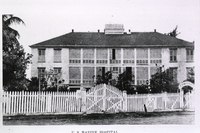 | Key West, Florida | 1845 | 1943 | Extant | | [2] [4] [9] [19] [38] |
| St. Marks, Florida | 1859 | ca. 1861 | Demolished | Museum currently exists on its site at San Marcos de Apalache Historic State Park | [2] [19] |
 | Pensacola, Florida | | | | First planned in 1840s and 1850s but never built | [2] [8] [19] |
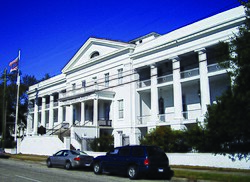 | Mobile, Alabama | 1843 | 1952 | Extant | Became Class II hospital after Civil War; NRHP-listed. See United States Marine Hospital (Mobile, Alabama) | [2] [4] [9] [19] |
 | New Orleans, Louisiana | 1847 | 1858 | Destroyed | Abandoned after floods; destroyed in 1861 explosion | [2] [9] [11] [5] [19] [20] [39] |
 | N/A | N/A | Demolished | Building partially constructed but never used as Marine Hospital; later used as insane asylum; hospital operated out of several temporary locations |
 | 1883 | 1933 | Demolished | Demolished and replaced with current building on same site |
 | 1933 | 1981 | Extant | |
 | Galveston, Texas/
Nassau Bay, Texas | 1931 | | | | [5] [40] [41] [42] |
 | 1970s | 1981 | Extant | Nassau Bay hospital opened in 1972 as a private hospital, but went bankrupt a few years later and was taken over by PHS, replacing the Galveston hospital; became Houston Methodist Clear Lake Hospital |
 | Fort Worth, Texas | 1938 | 1967 | Extant | Narcotics hospital; now Federal Medical Center, Fort Worth | [4] |
|
|---|
 | Carville, Louisiana | 1921 | 1999 | Extant | National Leprosarium; became NRHP-listed Carville Historic District | [4] [18] |
 | Natchez, Mississippi | 1852 | 1867 | Destroyed | Leased out after Civil War; became Natchez City Hospital; burned down in 1984 | [2] [6] [19] |
| Vicksburg, Mississippi | 1856 | 1870 | Demolished | | [2] [6] [19] |
| Napoleon, Arkansas | 1855 | ca. 1861 | Destroyed | Destroyed by flood in 1868. See Napoleon Marine Hospital | [2] [6] [19] |
 | Memphis, Tennessee | 1884 | 1965 | Extant | NRHP-listed; now Metal Museum | [4] [9] [19] [20] [43] [44] |
 | 1937 | 1965 | Extant | |
 | St. Louis, Missouri/
Kirkwood, Missouri | 1858 | 1939 | Demolished | Larger building constructed adjacent in 1882; demolished in 1959 | [2] [4] [6] [8] [9] [19] [20] [45] [46] |
 | 1939 | 1952 | Demolished | |
 | Cairo, Illinois | 1886 | 1919 | Demolished | | [9] [19] |
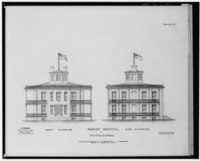 | Galena, Illinois | 1861 | 1868 | Extant | Later used as school and private residence | [2] [6] [19] |
| Burlington, Iowa | 1858 | 1865 | Demolished | | [2] [19] |
|
|---|
 | Paducah, Kentucky | 1852 | 1861 | Destroyed | During the Civil War, Fort Anderson was constructed around the hospital building, which burned in 1862 | [2] [6] [19] |
| Evansville, Indiana | 1856 | 1867 | Demolished | Demolished around 1912 | [2] [4] [9] [19] |
 | 1892 | 1947 | Demolished | Demolished early 1980s |
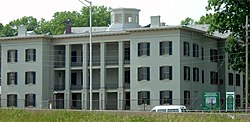 | Louisville, Kentucky | 1852 | 1946 | Extant | NRHP-listed. See United States Marine Hospital (Louisville, Kentucky) | [2] [4] [9] [19] |
 | 1933 | 1946 | Extant | |
 | Cincinnati, Ohio | 1860 | 1860 | Demolished | Became a military hospital upon completion and was never used as a Marine Hospital, later used by Good Samaritan Hospital; demolished ca. 1970. See United States Marine Hospital (Cincinnati) | [2] [8] [19] [20] [47] [48] [49] [50] |
 | 1882 | 1905 | Demolished | Located in former Kilgour Mansion, built around 1815; in 1912 it was reopened as PHS Stream Pollution Investigations Station. See United States Marine Hospital (Cincinnati) |
 | Lexington, Kentucky | 1935 | 1967 | Extant | Narcotics hospital; now Federal Medical Center, Lexington | [4] |
| Pittsburgh, Pennsylvania | 1851 | 1875 | Demolished | Demolished in late 1880s | [2] [4] [9] [51] [52] |
 | 1909 | 1949 | Extant | Converted to clinic, now occupied by Allegheny County Health Department's Frank B. Clack Health Center; part of NRHP-listed Lawrenceville Historic District. See United States Marine Hospital (Pittsburgh) |
|
|---|
| Burlington, Vermont | 1858 | 1866 | Destroyed | Never used due to lack of patients; became Home for Destitute Children; burned down in 1893 | [2] [19] |
 | Buffalo, New York | 1909 | 1949 | Extant | | [4] [9] |
 | Cleveland, Ohio | 1852 | 1929 | Demolished | Sold to Pennsylvania Railroad in 1929 and demolished; see Cleveland Marine Hospital | [2] [4] [9] [19] [53] [54] |
 | 1929 | 1953 | | became the Fairhill Mental Health Center; see Cleveland Marine Hospital |
 | Detroit, Michigan | 1857 | 1930 | Demolished | Main building demolished in 1962; 1933 building on site NRHP-listed as U.S. Immigration Station Detroit | [2] [4] [9] [19] [55] [56] |
 | 1930 | 1969 | Demolished | Demolished in 1984 |
 | Chicago, Illinois | 1852 | 1864 | Destroyed | At Fort Dearborn; sold; burned down in 1871 Great Chicago Fire | [2] [4] [9] [19] [20] [57] |
 | 1873 | 1965 | Demolished | Demolished for Disney Magnet School |
|
|---|
| Port Townsend/Port Angeles, Washington
| 1855 | 1858 | | Privately built and operated | [2] [4] [19] [20] [9] [58] [59] [60] |
| 1858 | 1893 | Destroyed | Originally privately built and operated under contract; purchased by government in 1883; burned down |
| 1862 | 1866 | Destroyed | Relocated to Port Angeles; destroyed by flood and restored to Port Townsend |
 | 1896 | 1933 | Demolished | Demolished in 1971 |
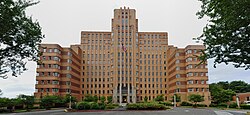 | Seattle, Washington | 1933 | 1981 | Extant | Replaced Port Townsend hospital; transferred to City of Seattle and became Pacific Tower | [4] [5] [61] [62] [63] |
 | San Francisco, California | 1854 | 1868 | Demolished | At Rincon Point; damaged by the 1868 Hayward earthquake and temporarily abandoned; later used as Sailor's Home and demolished in 1920s | [2] [5] [9] [19] [64] [65] |
 | 1875 | 1932 | | On the Presidio of San Francisco |
 | 1932 | 1981 | Extant | On the Presidio of San Francisco; reopened as apartments in 2010. See Public Health Service Hospital (San Francisco) |
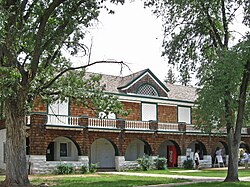 | Fort Stanton, New Mexico | 1898 | 1953 | Extant | Tuberculosis sanatorium; created from former Fort Stanton; NRHP-listed | [4] [19] |
 | Lahaina, Hawaii | 1844 | 1862 | Destroyed | See United States Marine Hospital (Lahaina, Hawaii) | [19] [66] |





























































